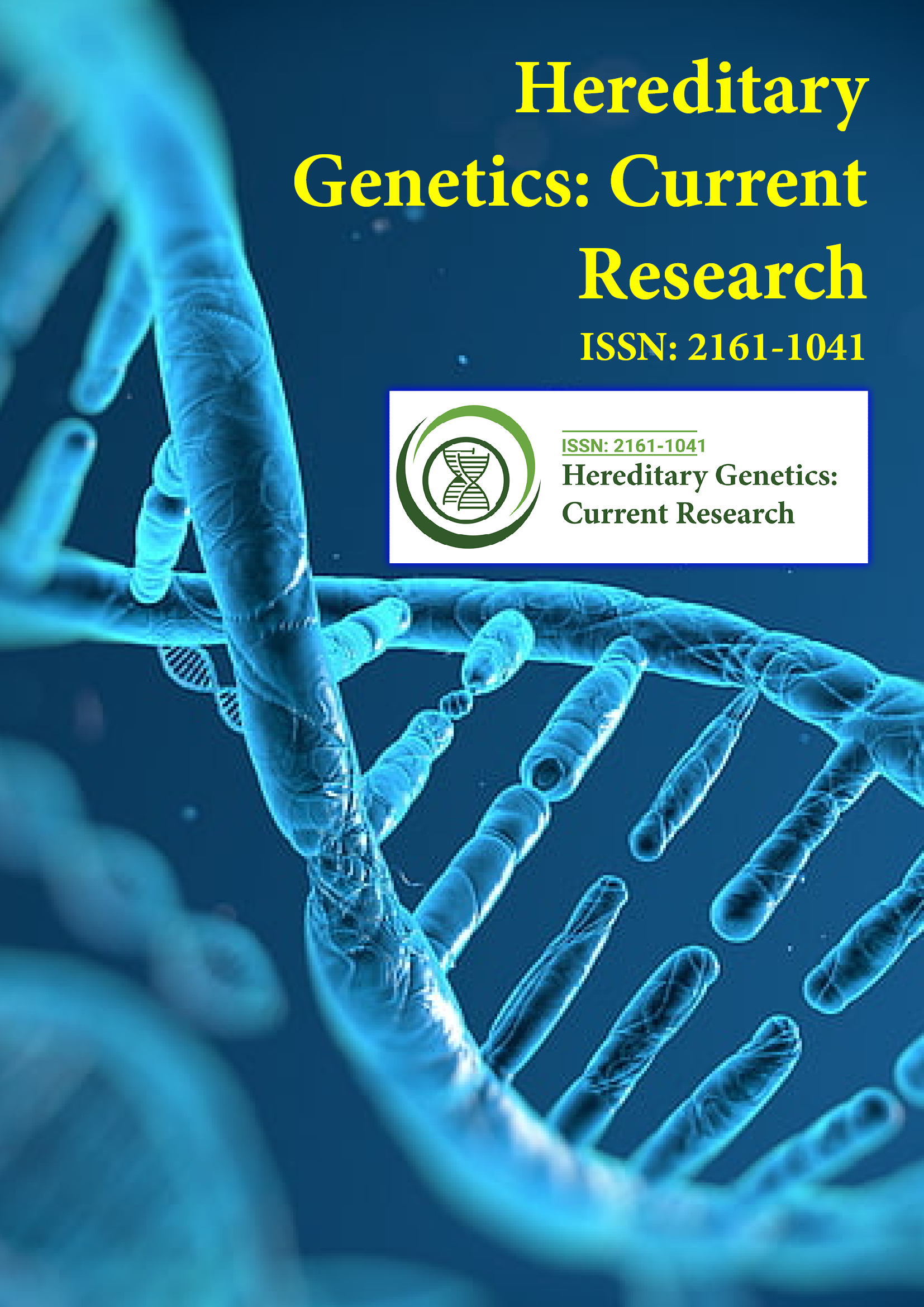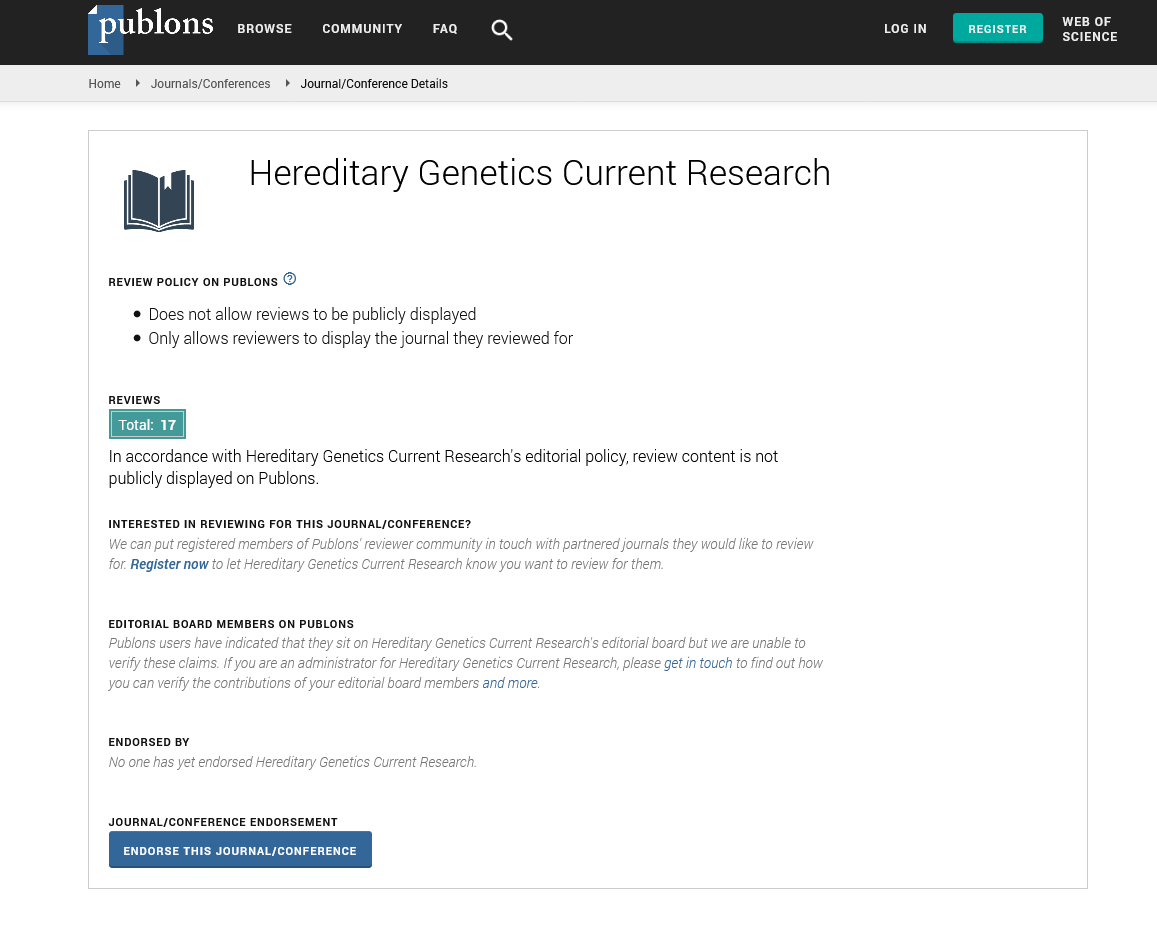Indexed In
- Open J Gate
- Genamics JournalSeek
- CiteFactor
- RefSeek
- Hamdard University
- EBSCO A-Z
- NSD - Norwegian Centre for Research Data
- OCLC- WorldCat
- Publons
- Geneva Foundation for Medical Education and Research
- Euro Pub
- Google Scholar
Useful Links
Share This Page
Journal Flyer

Open Access Journals
- Agri and Aquaculture
- Biochemistry
- Bioinformatics & Systems Biology
- Business & Management
- Chemistry
- Clinical Sciences
- Engineering
- Food & Nutrition
- General Science
- Genetics & Molecular Biology
- Immunology & Microbiology
- Medical Sciences
- Neuroscience & Psychology
- Nursing & Health Care
- Pharmaceutical Sciences
Perspective - (2024) Volume 13, Issue 1
Understanding Recurrent Section Syndrome Associated With Genetic Diseases
Figueroa Chang*Received: 27-Feb-2024, Manuscript No. HGCR-24-26561; Editor assigned: 01-Mar-2024, Pre QC No. HGCR-24-26561 (PQ); Reviewed: 15-Mar-2024, QC No. HGCR-24-26561; Revised: 22-Mar-2024, Manuscript No. HGCR-24-26561 (R); Published: 29-Mar-2024, DOI: 10.35248/2161-1041.24.13.276
Description
Compartment syndrome is a condition characterized by increased pressure within a muscle compartment, leading to insufficient blood supply to the tissue. While typically associated with trauma or intensive physical activity, a less commonly recognized form is Recurrent Atraumatic Compartment Syndrome (RACS). This article delves into RACS, particularly focusing on its manifestation as a genetic neuromuscular disease.
Understanding compartment syndrome
Compartment syndrome happens when the pressure inside a confined muscle compartment exceeds the capillary perfusion pressure, leading to reduced blood flow and subsequent ischemia of the muscle and nerves. This can lead to severe pain, weakness, and if untreated permanent damage. Acute Compartment Syndrome (ACS) often follows trauma, such as fractures or crush injuries while Chronic Exertional Compartment Syndrome (CECS) is typically seen in athletes and is induced by repetitive physical activity.
Recurrent atraumatic compartment syndrome
RACS deviates from the typical presentations of compartment syndrome. It is characterized by recurrent episodes of increased compartmental pressure without any preceding trauma or significant physical exertion. Patients with RACS experience periodic pain, swelling, and muscle tightness, often with no identifiable trigger.
Pathophysiology of RACS in genetic neuromuscular disease
The exact pathophysiological mechanisms linking genetic neuromuscular diseases to RACS remain under investigation. However, several hypotheses have been proposed:
Abnormal muscle metabolism: Genetic defects in metabolic pathways can lead to abnormal energy production and utilization in muscles, resulting in increased susceptibility to pressure changes and ischemia.
Structural muscle abnormalities: Mutations affecting muscle fiber structure can predispose individuals to increased compartmental pressures even without significant exertion.
Altered blood flow: Genetic conditions affecting vascular supply to muscles may contribute to intermittent ischemia, precipitating episodes of compartment syndrome. Increased susceptibility to edema: Some genetic conditions may lead to an increased propensity for fluid accumulation within muscle compartments, exacerbating pressure increases.
Clinical presentation and diagnosis
Patients with RACS secondary to genetic neuromuscular diseases typically present with episodic pain and swelling in the affected limbs. These symptoms often occur without an identifiable trigger, distinguishing RACS from exertional or traumatic compartment syndrome. Diagnosis involves a thorough clinical evaluation, including a detailed patient history and physical examination. Key diagnostic tools include:
Intracompartmental pressure monitoring: Measurement of compartment pressures can confirm the diagnosis. Elevated pressures during symptomatic episodes are indicative of compartment syndrome.
Genetic testing: Identifying underlying genetic mutations can help establish a definitive diagnosis of the associated neuromuscular disease.
Muscle biopsy: Histological examination of muscle tissue can reveal characteristic changes associated with specific genetic neuromuscular disorders.
Management strategies
The management of RACS in the context of genetic neuromuscular diseases poses unique challenges. Standard treatments for acute compartment syndrome, such as surgical fasciotomy, may not be appropriate or effective for RACS. Instead, a multidisciplinary approach is often required:
Physical therapy: Customized exercise programs can help maintain muscle function and prevent atrophy, while avoiding activities that may trigger symptoms.
Genetic counseling: For patients and families, genetic counseling provides valuable information about the hereditary nature of the condition and implications for family members.
Regular follow-up with a neurologist and other specialists is critical to manage the progressive nature of genetic neuromuscular diseases and monitor for potential complications. Several case studies have highlighted the occurrence of RACS in patients with genetic neuromuscular diseases. Individuals with mitochondrial myopathies have been reported to experience recurrent episodes of compartment syndrome, often linked to periods of metabolic stress or minor physical activity. These cases underscore the need for increased awareness among clinicians about the potential for RACS in this patient population. Ongoing research aims to further elucidate the mechanisms linking genetic neuromuscular diseases and RACS. Advances in genetic testing and molecular biology are expected to provide deeper insights into the pathophysiology of these conditions, ultimately leading to more effective diagnostic and therapeutic strategies. Recurrent atraumatic compartment syndrome represents a complex interplay between genetic, metabolic, and structural factors inherent in certain neuromuscular diseases. As research continues to develop the difficult of this relationship, improved outcomes for affected patients are anticipated through more personalized and targeted therapeutic approaches.
Citation: Chang F (2024) Understanding Recurrent Section Syndrome Associated with Genetic Diseases. Hereditary Genet. 13:276.
Copyright: © 2024 Chang F. This is an open access article distributed under the terms of the Creative Commons Attribution License, which permits unrestricted use, distribution, and reproduction in any medium, provided the original author and source are credited.

